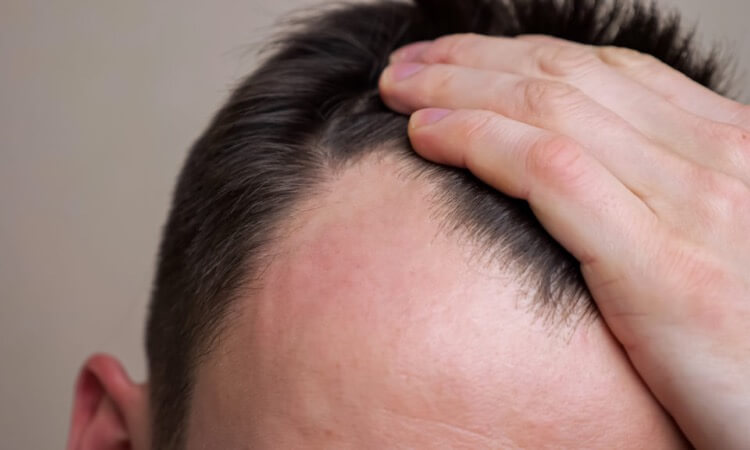Your Holiday Hair Loss Guide

‘Tis the season for parties, spending time with family and friends, and traditional holiday meals. It’s the most wonderful time of the year, right? Well, not for everyone. Some people dealing with hair loss find that the holidays bring a whole new level of angst about their appearance. You may plan to visit friends and family members you haven’t seen since last year, or even longer. And, for sure, you’ll end up in some of those pictures posted on Facebook or Instagram. Finding the perfect outfit is one thing, but trying to camouflage your thinning or balding hair is a whole different story. Is that even possible? Before you RSVP “no” to your next invite and pull out the flannels, take a deep breath and check out the following tips. You can find joy during the holidays, even when battling male or female pattern baldness or another type of alopecia.
Give Yourself a Break
It can be hard to accept that your looks are changing. You may not look like you did last year. Or, even like you did a few months ago. That’s okay. It’s time to stop comparing the new you to the old you. You’re probably harsher on yourself than others would be. When you see balding, thinning hair in the mirror, others may not even notice or care. They’re more likely to remember the funny story or joke you told. It’s true. While someone may remember what you look like, research indicates that others are more likely to remember how you make them feel when you’re around. (01) Do the best you can to turn off your inner critic, and remember that how you interact with others makes you uniquely attractive, not your hair.
Go Out and Stay Involved
Arg. Every time you look in the mirror, it seems like there’s more hair missing. You’re grumpy and don’t feel like talking to or seeing anyone. How can you go out looking like that? So, instead of going to your friend’s holiday party, you put on your baggiest sweats and start binge-watching Dahmer while downing a pizza. Good idea, right? Nope. According to the American Psychological Association, that’s the worst thing you can do. (02) Social isolation can not only affect your sleep, but also cause depression and lower your immunity. It can have long-lasting psychological effects. You’re better off rallying and forcing yourself to go to the party. Socializing will get your mind off your hair loss, even if it’s for a bit. Talking to other people will also help you feel less alone and put you in a better mood.
De-stress
Controlling stress is important for everyone’s health and well-being. It’s especially important if you’re dealing with hair loss. If you’re already experiencing male or female pattern baldness or another type of alopecia, you definitely do not want stress-induced hair loss too. The holidays are a particularly tricky time for managing stress, though. Family drama and searching for the perfect gift when there’s limited inventory can push anyone over the edge. The good news is that there are ways to manage. Here are some ways to help you de-stress:
1. Get enough exercise
Get outside or to the gym if your hair loss is giving you the holiday blues. Physical activity not only makes your body feel better, but it’s also good for your mind. Exercising may help increase your endorphins, putting you in a better mood after. Bonus is that exercise increases the blood flow to your scalp. This means that more oxygen and nutrients are helping kick your hair’s growth phase into full gear.
2. Sleep
Not only does sleep calm and restore your body, but it can also help hair growth. Your body produces melatonin primarily at night. Some studies even suggest that melatonin supplementation helps promote hair growth among people with male and female pattern hair loss. (03)
3. Pamper yourself
We’re going to put this out there. Sometimes the best way to relieve stress is to pamper yourself. Whether that’s a massage, listening to holiday music, or reading a book doesn’t matter. Whatever makes you let go and relax works.
4. Set a budget and stick to it
It’s easy to get burdened with extra debt and associated worries about how you will pay for all of those gifts during the holidays. Prevent that from happening by setting a budget and making sure that you stick to it.
5. Set a schedule
So much to do and so little time. The holidays will be here before you know it. How are you going to get everything done in time? Writing your to-dos down will help you manage your time and expectations. You’ll find time for the most important tasks, and you might even schedule some downtime.
6. Accept imperfections
Acknowledge that the holiday may not go as planned, and remember that imperfections are healthy and normal
7. Remember what’s important
Keeping perspective when you’re stuck in a long line or annoyed with a relative can go a long way toward keeping you calm. Will another 10 minutes really change your day? Does it matter that your sister wants to bring stuffing instead of pie?
8. Be patient
You can’t change others’ behavior, but you can choose how you respond. If a situation gets tense, take a few deep breaths and focus on an appropriate response versus a quick reaction.
Get a New Do
Maybe you’ve been letting your hair grow out, hoping to cover the balding or thinning areas. Or, perhaps you’ve been afraid to cut your hair because you’re worried it might not grow back. The holidays are the perfect time to visit your stylist and try out a new look. Remember, androgenetic alopecia is the most common form of hair loss. Millions of people are experiencing the same condition you are. Your barber or stylist probably has a few tricks to help you get party-ready.
Consider Treatment Options for Your Hair Loss
Accepting that your hair is thinning or balding isn’t easy, especially when you’re active and social. The good news is that you don’t have to accept your fate. The best way to deal with hair loss is by fighting it. Fortunately, medications with high efficacy have been tested and are available.
The most effective hair loss treatments are vasodilators and DHT blockers. Minoxidil is a vasodilator, which increases blood flow to your scalp and hair follicles. More oxygen enlarges the hair follicles allowing existing hair to remain stable and healthy. It also allows new hair to emerge.
Prescription DHT blockers serve a different purpose. Male and female pattern baldness occurs when testosterone converts to Dihydrotestosterone (DHT). DHT is what attacks your hair follicles and makes your hair fall out. DHT blockers prevent the conversion. The most commonly prescribed DHT blockers are Finasteride, Dutasteride, and Spironolactone. Because Minoxidil and DHT blockers treat hair loss from different angles, the two medications are often used simultaneously. Retinol may be prescribed as well to increase the absorption of the other medications. If irritation is a concern, low doses of cortisone can be added. All-in-one topical formulas prevent side effects and can be more convenient than oral medications.
Research Alternative Hair Loss Solutions
Prescription medications are a great choice for many people; however, there are alternative hair loss solutions that can help camouflage your hair loss and give your confidence a boost.
Hairpieces
Looking for a quick fix? Today’s hair pieces come in a wide variety of materials, textures and styles. Testing them out can be fun and can give you a fresh new look that will make you ready to rock the room.
Scalp Concealer
Some people with male and female pattern baldness swear by cover-up sprays and powders. The tint of color is just enough to conceal balding or thinning areas. A wide variety of colors are available to make a good color match, and the concealers are designed to be long-lasting.
Hair Transplants
If your hair loss is stressing you out and you don’t have the patience to wait for other treatments to work, you can always treat yourself to a hair transplant. Hair transplants are surgical procedures where healthy hair is moved from the back of your head to the front. Hair transplant practices have evolved over the years and produce a more natural look than ever before. Transplants can be pricey and aren’t usually covered by insurance since they’re considered cosmetic procedures.
Talk About It
It’s normal to be upset about losing your hair, but if your hair loss is starting to interfere with your holiday plans, you may need a support system. Using a therapist, meeting up with a group locally, or even joining a Facebook group for people with alopecia can help you feel less alone and develop coping skills. Finding a way to talk about your feelings may be one of the best gifts you give yourself this holiday season.
If the idea of stopping your hair loss and regrowing your hair brings you happiness and joy, what are you waiting for? It’s time to get more information on customized hair growth solutions. The best part about our prescription-grade solutions is that ingredients can be added or removed based on your particular needs. Get started now and check out our special edition holiday pack.
Resources:
(01) https://pubmed.ncbi.nlm.nih.gov/25750481/
(02) https://www.uvu.edu/news/2020/04/04072020_isolation_mental_health.html#:~:text=The%20American%20Psychological%20Association%20reports,have%20long%2Dlasting%20psychological%20impact.
(03) https://www.ncbi.nlm.nih.gov/pmc/articles/PMC3681103/



